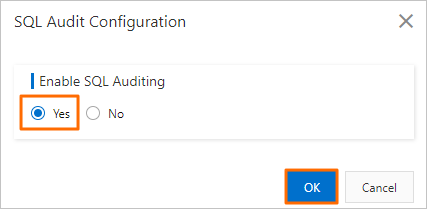AnalyticDB for MySQL provides the SQL audit feature to log real-time DML and DDL operations that are executed in databases. You can query database operation information from audit logs.
Limits
The following operations are not recorded in SQL audit logs:
INSERT INTO VALUESREPLACE INTO VALUESUPSERT INTO VALUES
Enable or disable SQL audit
- Log on to the AnalyticDB for MySQL console.
- In the upper-left corner of the page, select a region.
- In the left-side navigation pane, click Clusters.
On the Data Warehouse Edition (V3.0) or Data Lakehouse Edition (V3.0) tab, find the cluster that you want to manage and click the cluster ID.
Go to the SQL Audit page.
For an AnalyticDB for MySQL Data Warehouse Edition (V3.0) cluster, click Data Security in the left-side navigation pane and then click the SQL Audit tab.
For an AnalyticDB for MySQL Data Lakehouse Edition (V3.0) cluster, choose in the left-side navigation pane.
Click Configure SQL Audit.
In the Configure SQL Audit dialog box, select Yes and click OK.

If you no longer need the SQL audit feature, repeat Steps 1 to 6 and then select No in the Configure SQL Audit dialog box.
ImportantAfter you disable SQL audit, SQL audit logs are cleared. You must query and export SQL audit logs before you disable SQL audit. For more information, see the "Query and export SQL audit logs" section of this topic. When you re-enable SQL audit, audit logs that are generated from the time when SQL audit was last enabled are available for queries.
Query and export SQL audit logs
On the SQL Audit tab, you can query SQL audit logs within a specific period of time by using the Operation Type or Execution Status parameter.
You can query only SQL audit logs that were generated within the last 30 days.
The time range for a single query must be within 24 hours. If you want to save SQL audit logs to your on-premises device, click Export Current Page.
FAQ
Q: The INSERT OVERWRITE statement involves two SQL audit logs, and one of the logs contains an IP address other than the client IP address. Why?
A: The INSERT OVERWRITE statement is executed in AnalyticDB for MySQL in an asynchronous manner. The AnalyticDB for MySQL access node allocates query jobs to different storage nodes and returns the final result to the client. In this case, the SQL audit logs contain the IP address of the client that submits a request and the IP address of the AnalyticDB for MySQL access node.
Related operations
Edition | Operation |
Data Warehouse Edition (V3.0) | |
Data Lakehouse Edition (V3.0) | |